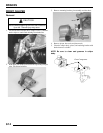
9.7
BRAKES
9
This system also incorporates a diaphragm (E) as part of the
cover gasket; and a vent port (F) located between the gasket and
the cover. The combination diaphragm and vent allow for the air
above the fluid to equalize pressure as the fluid expands or
contracts. Make sure the vent is open and allowed to function.
If the reservoir is over filled or the diaphragm vent is plugged the
expanding fluid may build pressure in the brake system leading
to brake fail
When servicing Polaris ATV brake systems, use only Polaris
DOT-approved brake fluid.
Brake Noise Troubleshooting
Dirt or dust buildup on the brake pads and disc is the most
common cause of brake noise (squeal caused by vibration). If
cleaning does not reduce the occurrence of brake noise, a
product such as Permatex
Disc Brake Quiet can be applied to
the back of the pads. Follow directions on the package. This will
keep pads in contact with caliper piston(s) to reduce the chance
of squeaks caused by dirt or dust.
Brake Bleeding / Fluid Change
NOTE: When bleeding the brakes or replacing the
fluid, always start with the caliper farthest from the
master cylinder.
NOTE: Do not remove brake lever when reservoir
fluid level is low.
This procedure should be used to change fluid or bleed brakes
during regular maintenance.
1. Clean reservoir cover thoroughly.
2. Remove screws, cover and diaphragm (C) from reservoir.
WARNING
Once a bottle is opened, use what is necessary and
discard the rest in accordance with local laws. Do
not store or use a partial bottle of brake fluid. Brake
fluid is hygroscopic, meaning it rapidly absorbs
moisture. This causes the boiling temperature of
the brake fluid to drop, which can lead to brake fade
and the possible loss of control.
BRAKE NOISE TROUBLESHOOTING
POSSIBLE CAUSE REMEDY
Dirt, dust, or imbedded
material on pads or disc
Spray disc and pads with CRC
Brake Kleen
or equivalent
non-flammable aerosol brake
cleaner. Remove pads and/or
disc hub to clean imbedded
material from disc or pads.
Pad(s) dragging on disc (noise
or premature pad wear)
Adjust pad stop
Insufficient lever or pedal
clearance
Set to proper level
Master cylinder reservoir
overfilled
Check brake fluid level,
adjust as needed
Master cylinder
compensating port
restricted, Master cylinder
piston not returning
completely, Caliper piston(s)
not returning
Clean piston(s) seal
Operator error (riding the
brake / park brake
applied)
Educate operator
Loose wheel hub or bearings
Tighten wheel, hub nuts or
replace bearings if worn
Brake disc warped or
excessively worn
Replace disc
Brake disc misaligned or
loose
Inspect and repair as
necessary
Noise is from other source
(chain, axle, hub, disc or
wheel)
If noise does not change when
brake is applied check other
sources. Inspect and repair as
necessary
Wrong pad for
conditions
Change to a softer or harder
pad (if available)
CAUTION
Always wear safety glasses during these
procedures. Brake fluid will damage finished
surfaces. Do not allow brake fluid to come in contact
with finished surfaces.
BRAKE NOISE TROUBLESHOOTING
POSSIBLE CAUSE REMEDY


















